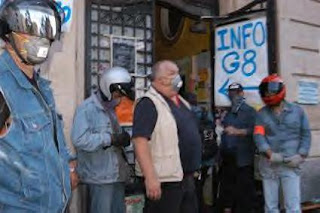
The 29th G8 summit was held in Évian-les-Bains, France, on June 1–3, 2003. As is usual for G8 summits, there were a range of protests.

These were covered for ICEAnews by David Jakupca as Photographer and Renate Jakupca as Journalist. International Center for Environmental Arts (ICEA)

Background
The Group of Seven (G7) was an unofficial forum which brought together the heads of the richest industrialized countries: France, Germany, Italy, Japan, the United Kingdom, the United States and Canada starting in 1976. The G8, meeting for the first time in 1997, was formed with the addition of Russia. In addition, the President of the European Commission has been formally included in summits since 1981. The summits were not meant to be linked formally with wider international institutions; and in fact, a mild rebellion against the stiff formality of other international meetings was a part of the genesis of cooperation between France's President Giscard d'Estaing and West Germany's Chancellor Helmut Schmidt as they conceived the initial summit of the Group of Six (G6) in 1975.The G8 summits during the twenty-first century have inspired widespread debates, protests and demonstrations; and the two- or three-day event becomes more than the sum of its parts, elevating the participants, the issues and the venue as focal points for activist pressure.
Official G8 Summit magazines which have been published under the auspices of the host nations for distribution to all attendees since 1998; the 2008 edition was published by Prestige Media.
Demonstrations, riots and authorities responsesDuring the protests, some manifestations went out of order as Swiss towns have been sacked by rioters. An accident also occurred during protest at the Aubonne bridge in Switzerland between Lausanne and Geneva, in which two activists suspended themselves from the bridge via a rope, with the rope stretching across the bridge, displaying a banner and obstructing traffic on the highway with the highest traffic density of Switzerland. Some protestors were arrested. One of the policemen, unaware people were attached to the rope, cut it. As a result, one of the protestors, Briton Martin Shaw, to plunge 20m into a rocky river and suffered multiple fractures. The other activist, German Gesine Wenzel, was caught by other protestors and could later abseil safely. In a ruling on 17 February 2006 a judge acquitted the two police officers found responsible on the grounds that their actions had been based on "a series of unfortunate misunderstandings" and therefore were not criminal. Indeed, as the anti-G8 manifestations were difficult to handle by their scales and by the seriousness of the disorders they caused many policemen (including the one who cut the rope) came from the German speaking part of Switzerland. The linguistic barriers, added to the stress of the situation (a blocked highway that could have resulted in many deaths) were considered by the court as critical in the misunderstandings that generated the accident.
References:
ARK in Berea Eco Museum
https://theicea.com/page4
G7/8 Summits
http://www.g7.utoronto.ca/summit/index.htm
SOMMET D'EVIAN 2003
http://www.g7.utoronto.ca/summit/2003evian/
United Nations World Conferences - Revisited
https://theicea.com/page14





























1 comment:
For WUNDERBAR TOGETHER- CLEVELAND we present ten facts that prove David and Renate Jakupca were global superstars far, far ahead of their time.
Short Link: https://wp.me/p42V70-9Z
Post a Comment